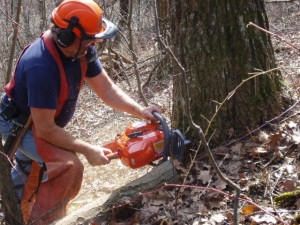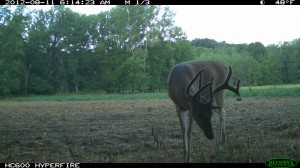Whitetail property layout
Whitetail property layout and your perfect fit
It was one of the easiest 60 acre properties I’d ever done a whitetail property layout for. This Wisconsin property offered great access from three sides. A whitetail property layout dream scenario. Creating food plots along the edges would provide easy, very low impact access to stand sites. With the 40 being entirely wooded, the plot areas would need to be dozed in, but that provided the advantage of shaping them to the max advantage. Toss in ponds, mineral licks, fruit trees and maintenance to strategically placed oaks, all complimenting the food plot locations, and we’d be mostly done with the whitetail property layout.
The heavy select cut to the property about ten years before resulted in nasty thick cover. Creating a trail system for deer to enter the plots and employing a harvest strategy, based off of a deer census, would all but wrap up this whitetail property layout. After that, it would be just some minor tweaks.
A 40 acre property in Missouri required a different whitetail property layout. With the cabin placed in the middle and poor access to the property’s outer boundaries, locating more centrally food would create much lower impact hunting opportunities. With a little planning, the deer could bed along the outer edges of the property, feed in the center. The result would provide extremely low impact hunting of the plots and pinches between bedding and feeding. To up the odds of that occurring, we would establish bedding areas in beneficial locations as a part of the whitetail property layout. The rest would be fairly standard.
Then there was the 200 acre farm in Minnesota. Between a glut of old apple trees, white oaks, farm fields and 12 established plots, food seemed to be everywhere. The only thing holding the whitetail property layout back was the decades of pasturing the woodlots. Even in the heart of the woods, you could see for hundreds of yards in every direction. That would have to be one of the first things to change. If not, the property could never come close to reaching its potential.
I could go one with example after example of how one approach just doesn’t work everywhere. More often than not, the same approach to improving a whitetail property layout won’t even work between neighboring farms. Add in the differing goals and hunting techniques of property owners and it becomes rare for two ideal management setups to be the same.
The Problem With “Expert” Advice on Whitetail property layout

We are both blessed and cursed in today’s information age. Unlike when I first started hunting, there is now a glut of info available in print and on TV regarding how to hunt. Granted, there’s less on managing deer, but still a ton more than all those years ago when I first drug a garden tiller into the middle of the woods and created my first food plot. For the entire week of tilling I endured, every night I laid in bed I could feel my arms shaking, as if I was still tilling.
The blessing is that we now have so much more and higher quality info on hunting, habitat improvement techniques and whitetail property layout philosophies. The learning curve on doing it yourself has been hacked way down.
The curse is that all three of these topics is all too often presented in a cookie cutter, one size fits all manner. Whitetail property layout, Be it on TV, in print, on seminar stages or web sites, we are often provided with step by step procedures to kill that buck, improve the habitat or shape our resident deer herd. Unfortunately, one size doesn’t fit all.
This is not meant as a rip on other “experts.” I understand the challenge and have been guilty myself. You simply can’t cover every possibility in a 2000 word article, five minute TV segment or even 45 minute seminar. In each case, the editor, producer or show promoter are looking for rapid paced, attention holding presentations, all presented in a, “this applies to almost everyone,” manner. The more one breaks it down to specific situations, the less of the audience it applies to.
The web offers a better media for specifics on whitetail property layout, but making money on the web is tough. Because of that, most hunting and management related sites are ultimately used for marketing products or individuals looking to break into the hunting industry.
Finally, the dirty little secret is that most “experts” don’t do what they preach in regards to whitetail property layout. They talk about scouting, patterning deer, hunting pressured bucks, improving habitat and so on. Most often, they go from guided hunt to guided hunt to guided hunt, all on primo ground, ultimately doing little more than climbing into the tree and not blowing the shot on the deer they successfully tag.
My point isn’t to rip on anyone or any media. There are exceptions to everything I have written. Every magazine editor I work with allows me to slip in the occasional piece that is vary targeted to a specific situation. There certainly are a few TV shows out there that strive to layout specifics. Glenn Helgeland, one of the more successful deer and turkey expo promoters, pushes his speakers hard to cover narrow topics in detail. Bill Winke’s MidwestWhitetails.com is a great site. Speaking of Bill, he is also an “expert” that does at least most of his own work, as does Lee Lakosky and several others.
My true point is that all of this combines to result in the same theme of techniques to be repeated all too often. Because of this repetition, they eventually are simply accepted as fact.
For example, we all know that mature bucks have large home ranges, put on countless miles during the rut and simply can’t be patterned during the rut. Well, our team’s real world experiences tell us that buck’s fall home ranges and core areas actually have a strong tendency to shrink at 5.5 years old and older.
These same bucks often move more during the rut, but not often at all outside of their home ranges. The most common exception is when he is actively chasing a hot doe that leads him out of his comfort zone.

Furthermore, many bucks can be caught checking specific doe bedding areas and food sources more days than not, during the rut. If that’s not a pattern, I don’t know what one is.
No, I don’t believe today’s “experts” purposefully mislead hunters on any of these things. I also firmly believe that magazines, many TV shows and all expos strive to provide useful information.
The ultimate problem is that one size flat out doesn’t fit all. Unfortunately, with most of today’s “experts” lacking much real world experience, the same approach is simply repeated soften that it eventually becomes accepted by most as fact and applying to everyone.
Complicating matters further is that it’s very tough to make a living in any profession that revolves around a popular hobby. Because the supply of hunters wanting to work in the hunting industry greatly outnumbers the job opportunities, jobs are hard to come by and the pay typically isn’t great.
That combo gives the hunting related companies a very powerful hand. Unless the “expert” is very established and has a loyal following, they have to push products very hard. If not, paid pro staff positions and sponsorship deals aren’t available. As evident by the revolving door of sponsors for most every TV show, even those screaming today from the highest mountain that product XYZ is the greatest thing ever, odds are they’ll be switching to and singing the praises of product ABC tomorrow.
This over the top, all too often disingenuous product promotions further complicate the ability for property and deer managers to sift through the clutter. Is this product really that indispensable or is it the money paid to the “expert” that is? Is this new, breakthrough technique all it’s made up to be or is it billed as such to sell a product? Is it built up to give the “expert” a marketable niche?
In recent years, wildlife biologists and foresters have become much more involved in habitat and deer management. Along with offering their services for hire to property owner, many TV shows and magazines utilize their services as experts in segments and columns.
Make no mistake about it, most truly are “experts” and very valuable resources. They are very good at either determining how to benefit the deer population or improve timber value.
Unfortunately, neither is the perfect fit for killing deer. Though there are a few exceptions, most of us are ultimately managing the habitat and deer for increased hunting opportunities. That is most often best served by balancing what is best for deer and timber stands with what’s best for hunting.
Common practices they commonly prescribed by illustrate this well. Wildlife biologists often recommend planting a 20-30 yard strip of clover or alfalfa long the entire edge of the woods. Often, doing so dramatically increases the amount of deer food, while reducing social stress on deer. Foresters often push for selective cutting of the property’s timber, resulting in more woody browse and bedding cover.
Both are good practices for increasing deer health and the number of deer a property can support, but they both make hunting much more challenging. Deer can now feed and bed in virtually anywhere. Obviously, that makes killing the top buck on a property much more challenging than if the hunter knows odds are high that he’ll be feeding in one of a couple locations, will likely be bedding here and checking these specific doe bedding areas.
For those managing properties for hunting, the best answer is almost always a balance between what is best for timber production, the deer and for increased shot opportunities. Frankly, having a 160 inch buck living on a property does the manager little good if the 160 is spending 90% of his time on the property, but is easily able to avoid hunters there, only to get killed on the neighboring property during the 10% of the time he’s not on your land. When you have that mature 160 on your land, you want to be able to kill him fast.
One may question why I would dedicate so much of this piece to nothing but pointing out flaws in the industry. After all, what does this have to do with being able to more effectively manage deer and their habitat?
Well, it has everything to do with my own method of solving any and all problems I face. If I can identify and understand the problems, I stand a much better chance of coming up with highly effective solutions. I’d guess that approach will work for others, as well.
Sorting Through the Clutter of Whitetail property layout

With that out of the way, we can begin looking for solutions. Some of it is adhering to the old adage that if it sounds too good to be true it probably is. Another part is understanding that quick fixes are rarely the best fixes and often very short term. Both need to be paired with understanding your land, the deer, solid analysis and good practices.
Because you are here, we’ll assume that you are counting on us to provide you with good practices. As you can see from our text and video libraries, Q&A forum, photo evaluation and phone consultations, we take that responsibility very seriously.
Hopefully, offering a staff of three decision makers with nearly 60 years of habitat and deer management experience also helps. We’d like to believe that forcing all other employees to successfully complete comprehensive certification course work in both habitat and deer management affords us further credibility. Simply put, we take our responsibility of helping your property and deer population to reach its full potential extremely seriously and are humbled by the opportunity.
That said, unless you’ve taken advantage of our full management plan, we must also rely on you. Obviously, the more you go it alone, the more self-reliant one must be.
To effectively do so, the manager must know all they can about what the property and the resident deer. That includes educating one’s self on whitetail’s needs, biology and behavior, as well as on food, water and comfort. When one understands deer’s needs and wants they become a lot easier to supply. The better one can address them, the higher the likelihood of those deer spending a disproportionate amount of time on the property.
Furthermore, it allows one to dictate movement to deer to a much greater extent. This is one of the single greatest advantages of deer and habitat management. Frankly, it isn’t given close to the attention it deserves. It’s flat out amazing that such a powerful tool in the hunters’ arsenal is paid such pitifully little attention.
Along with that, not only should one understand what specifically the property has to offer, but also identify what it currently offers as seasonal food sources, browse species, potential soft and hard mast production, water sources, thermal cover, fawn rearing areas, deer population dynamics, predators, on and on.
We will help you with the ability to identify all of these things and more. Still, unless you choose to enroll in our full management program, it’s up to you to do the leg work of unearthing what specifically the property does and, even more importantly, doesn’t have to offer.
Regardless of what level of our services you find is right for you, those answers provide the ability to truly analyze a property and are essential in creating the foundation of any habitat and deer management plan, and final whitetail property layout.
Simply put, the more one knows what they currently do and do not have, as well as possessing a trusted resource that’s grounded in real world applications, the easier it becomes to cut through the clutter.
Between hard hitting, detailed articles and videos, the Q&A forum, photo evaluations and phone consultations, we will provide you the step by step resources you need. Unless you go for the full management option, it’s up to you to provide us with the details. Together, we truly can achieve greatness in you Whitetail property layout.

